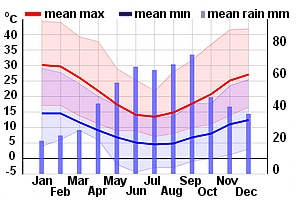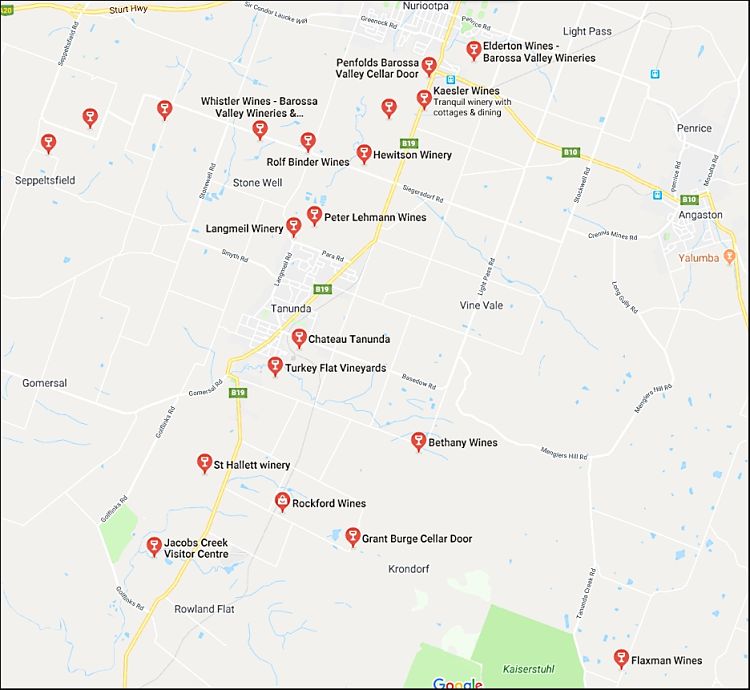Jump to Winery List
Barossa Valley Wine Region
The famous Barossa Valley Wine Region has a rich food and wine culture that is showcased in its premium wines, bountiful seasonal fresh food and specialty food products. There is a wide range of wonderful foods produced which include boutique and specialty cheese and breads, reflecting the German influence of the communities, unique smoked and cured meats. Take a day a week or longer to visit this region that has so much to offer including fabulous and renowned premium wines, fabulous food at its cafes and restaurants, heritage architecture, a wonderful variety of accommodation and warm and friendly communities in its various towns and Villages. Most of the Barossa Valley is flat with elevations less than 400 m above sea-level. The region stretches from Williamstown in the south to Kapunda
and Truro in the north. The main centres are Angaston, Nuriootpa, Tanunda, Bethany, Rowland Flat, Lyndoch, Williamstown. Enjoy the great facilities supporting and treasure trove of diverse activities including food and wine festivals, special events, entertainment, the arts, cycling, shopping, bushwalking, golf - all within a stunning Australian landscape of rolling hills. The Barossa has a typical Mediterranean climate with dry summers with maximum temperatures between 30 and 35 degrees Centigrade. The winters are cool and wet winters with maximum temperatures between 8 and 20 degrees C. Most or the average rainfall of 550 mm occurs between April and October, and the Barossa has traditionally been a rainfall restricted yield region, that has no relied on irrigation. This has ensured maximum
flavour and high quality grapes. The Barossa is home to more than 700 grape growing families and more than 160 wine companies. The Barossa Valley is renowned for its full bodied reds, such as - Cabernet Sauvignon, Shiraz and Grenache - and lovely whites - Semillon, Riesling and Chardonnay. Several less known varieties are also grown including Viognier, Tempranillo, Sangiovese, Marsanne, Savagnin. The strength and success of the Barossa has come from its variety and specialisation on varieties that are suited to the region. Dedicated wine lovers will locate the small winemakers that produce the type and style of wines that they like. The first grape vines were planted in the early 1840s and many of them are still producing first class fruit, because the Barossa never suffered from phylloxera,
that devastated most vineyards elsewhere in Australia. Christian Auricht planted the first rows of Shiraz vines in 1843 on the flats near the North Para River at Langmeil village. This vineyard is still producing wine.
The Barossa Valley Wine Region includes sixteen districts :
Marananga ;
West Nuriootpa ;
East Nuriootpa ;
Dorrien ;
Tanunda ;
Vine Vale ;
Bethany ;
Rowland ;
Lyndoch North ;
Lyndoch South ;
Williamstown ;
Gawler ;
Koonunga ;
Truro ;
Angaston ;
Light Pass


Search for a Winery
- Arno Wine Co., SA
- Artisans of Barossa, SA
- Atze’s Corner Wines, SA
- Ballycroft Vineyard and Cellars, SA
- Barossa Boy Wines, SA
- BarossaValleyEstate, SA
- Beer Brothers Wines, SA
- Bethany Wines, SA
- Brockenchack Vineyard, SA
- Burge Family, SA
- Calabria Family Wines, SA
- Charles Cimicky, SA
- Charles Melton Wine, SA
- Chateau Tanunda, SA
- Craneford Wines, SA
- Domain Barossa, SA
- Dorrien Estate, SA
- DutschkeWines, SA
- Elderton Wines, SA
- Elysian Springs, SA
- Gibson's Wines, SA
- Glaetzer Wines, SA
- God's Hill Wines, SA
- Gomersal Wines, SA
- Grant Burge Wines, SA
- Greenock Creek Wines, SA
- Hamilton`s Ewell, SA
- Harbord Wines, SA
- Hart of the Barossa, SA
- Hayes Family Wines, SA
- Heathvale Wines, SA
- Hemera Estate, SA
- Henschke Cellars, SA
- Heritage Wines, SA
- Hewitson, SA
- Hutton Vale, SA
- Izway Wines, SA
- Jacobs Creek, SA
- Jenke, SA
- John Duval Wines, SA
- Kaesler Wines, SA
- Kalleske Wines, SA
- Kapunda Distillery, SA
- Kellermeister, SA
- Kies Family, SA
- Krondorf, SA
- Lambert Estate Wines, SA
- Langmeil Winery, SA
- Lanzerac, SA
- Laughing Jack Wines, SA
- Liebichwein, SA
- Linfield Road, SA
- Lou Miranda Estate, SA
- Mad Dog Wines, SA
- Michael Hall Wines, SA
- Moorooroo Park Vineyards, SA
- Murray Street Vineyard, SA
- Paisley Wine, SA
- Peter Lehmann, SA
- Red Gum, SA
- Redheads Wine, SA
- Rieslingfreak, SA
- Rockford Wines, SA
- Rojomoma, SA
- Rolf Binder Winery, SA
- Rosenvale Wines, SA
- Ross Estate, SA
- Rusden Wines, SA
- Salter and Son, SA
- Saltram Wine Estate, SA
- Schild Estate, SA
- Schubert Estate, SA
- Schwarz Wine Co., SA
- Seabrook Wines, SA
- Seize the Day Wines, SA
- Seppeltsfield Barossa, SA
- St Hallett Wines, SA
- St Hugo, SA
- Steinborner & Reynolds, SA
- Tait Wines, SA
- Tart & Tawny, SA
- Te-aro Estate, SA
- The Willows, SA
- Thorn Vineyards, SA
- Thorn-Clarke Wines, SA
- Thorn-Clarke Wines, SA
- Torbreck, SA
- Torbreck Vintners, SA
- Turkey Flat, SA
- Two Hands Wines, SA
- Ubertas Wines, SA
- Veritas Winery, SA
- Viking Wines, SA
- Whistler Wines, SA
- Willows Vineyard, SA
- Wolf Blass, SA
- Yaldara Wines, SA
- Yalumba, SA
- Yelland and Papps, SA
No Match for Your Search